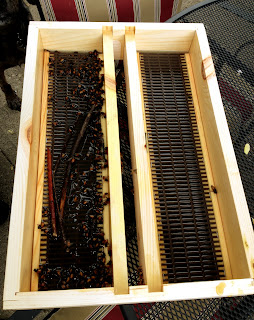I started doing some research about 2012 Pollinator Week and was surprised that Kentucky has yet to officially participate. Being that Kentucky has some pretty amazing agricultural programs in place, I thought it would be worth a shot to send Governor Beshear a letter to request his support. Of course I understand that one letter from one person probably won't get much response, but I'm hoping that the seed of the idea of a Kentucky Pollinator Week will at least get planted.
Yes, petitioning for Kentucky Pollinator Week may seem less important than raising awareness for global hunger, illness, war, abuse, or global warming, but I really feel like this is something small that I can do as a hobbyist to generate interest and remove myths surrounding pollinators, and specifically honeybees.
I'll post any response that I get.
May 19, 2012
Governor Steve Beshear
700 Capitol Avenue Suite 100
Frankfort, Kentucky 40601
Dear
Governor Beshear:
Five
years ago the U.S. Senate’s unanimous approval and designation of the final
week in June as “Pollinator Week” marked a necessary step toward addressing the
urgent issue of declining pollinator populations. Last year
37 states declared their own state Pollinator Week. With your help, we hope to reach 100% state
participation this year. The popularity
and public enthusiasm for Pollinator Week has been overwhelming. In 2012 we can continue to build on
the tremendous success of this movement with
your involvement.
Pollinator Week has become an international
celebration of the invaluable ecosystem services provided by bees, birds,
butterflies, bats and beetles. The growing concern for pollinators is a sign of
progress, but it is vital that we
continue to maximize our collective effort.
Thus,
I am writing to ask for your support in helping to protect pollinating animals,
which are vital to our food supply, economy, and a key to global
sustainability, by declaring “Kentucky Pollinator
Week,” June 18-24, 2012.
Kentucky’s
amazing “Kentucky Proud” program already promotes the unique diversity of
Kentucky farm products, and with your help, Kentucky Pollinator Week will raise
awareness and understanding for the vital pollinators that are an extremely
important part of Kentucky’s agricultural system.
In the landmark study, Status of Pollinators in North America, the National Academy of
Sciences and National Research Council recommends an immediate increase in
public awareness of the vital roles pollinators play in our lives. By declaring Pollinator Week in Kentucky, you will be helping to do exactly
that.
Please consider joining this movement to protect
one of the foundations of life that has been largely ignored. A sample
proclamation is enclosed. Thank you for supporting the great state of Kentucky and its citizens through your advocacy
for pollinators.
Sincerely,
Becky Anderson




















